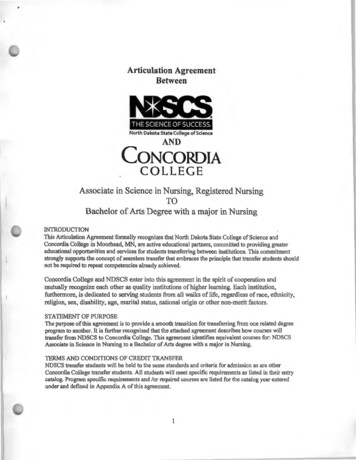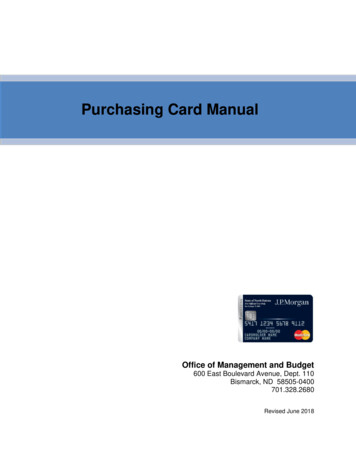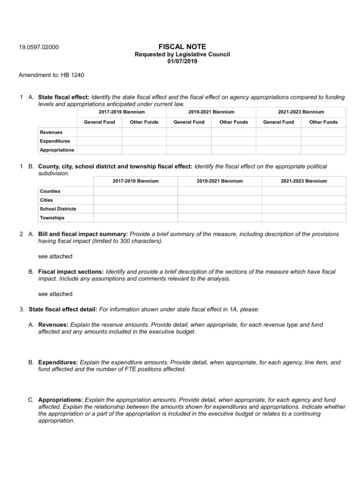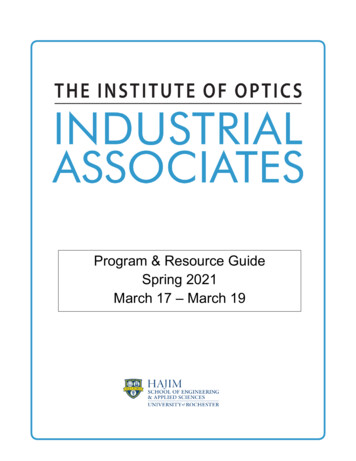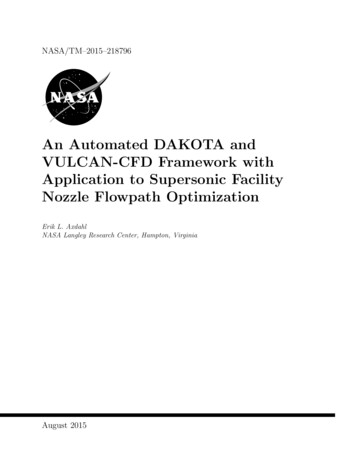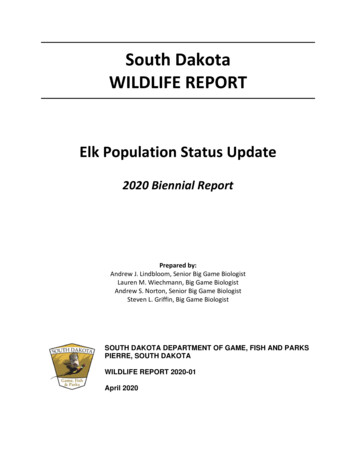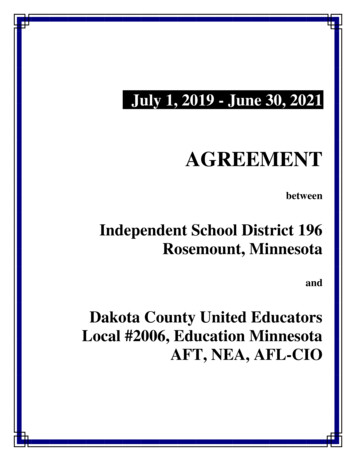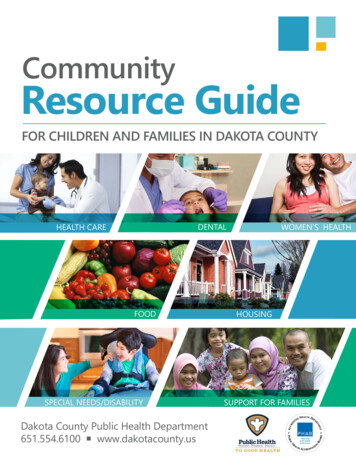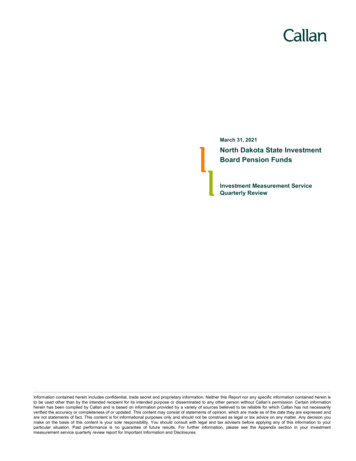
Transcription
March 31, 2021North Dakota State InvestmentBoard Pension FundsInvestment Measurement ServiceQuarterly ReviewInformation contained herein includes confidential, trade secret and proprietary information. Neither this Report nor any specific information contained herein isto be used other than by the intended recipient for its intended purpose or disseminated to any other person without Callan’s permission. Certain informationherein has been compiled by Callan and is based on information provided by a variety of sources believed to be reliable for which Callan has not necessarilyverified the accuracy or completeness of or updated. This content may consist of statements of opinion, which are made as of the date they are expressed andare not statements of fact. This content is for informational purposes only and should not be construed as legal or tax advice on any matter. Any decision youmake on the basis of this content is your sole responsibility. You should consult with legal and tax advisers before applying any of this information to yourparticular situation. Past performance is no guarantee of future results. For further information, please see the Appendix section in your investmentmeasurement service quarterly review report for Important Information and Disclosures.
Table of ContentsMarch 31, 2021Executive SummaryActive Management Overview2Capital Market Review3NDSIB - Consolidated Pension TrustActual vs Target Asset Allocation19Quarterly Total Fund Attribution20Cumulative Total Fund Attribution21Historical Asset Allocation25Asset Class Risk and Return26Total Fund Ranking27Asset Class Rankings28Investment Manager Asset Allocation29Investment Manager Returns32NDSIB - Public Employees Retirement SystemActual vs Target Asset Allocation38Quarterly Total Fund Attribution39Cumulative Total Fund Attribution40Cumulative Performance44Historical Asset Allocation45Asset Class Risk and Return46Total Fund Ranking47Asset Class Rankings48Asset Class Allocation49Asset Class Returns50NDSIB - Teachers Fund For RetirementActual vs Target Asset Allocation53Quarterly Total Fund Attribution54Cumulative Total Fund Attribution55Cumulative Performance59Historical Asset Allocation60Asset Class Risk and Return61Total Fund Ranking62Asset Class Rankings63Asset Class Allocation64Asset Class Returns65
Table of ContentsMarch 31, 2021Domestic EquitiesDomestic Equities Composite68L.A. Capital Management69L.A. Capital Management Enhanced Index70Northern Trust AM Enhanced S&P 50071Parametric Enhanced S&P 50072Atlanta Capital73Riverbridge Small Cap Growth74Sycamore Small Cap Value75International EquitiesInternational Equities Composite77DFA International Small Cap Value Fund78Northern Trust AM World ex US79Wellington Management Company80William Blair81Axiom Emerging Markets82DFA Emerging Markets83World EquitiesEPOCH Investment Partners85LSV Asset Management86Private EquitiesInvestment Manager Returns88Domestic Fixed IncomeDomestic Fixed Income Composite90Declaration Total Return91PIMCO DiSCO II92PIMCO Core Plus Constrained93Prudential Core94SSgA Long US Treasury Index95Ares ND Credit Strategies Fd96Cerberus ND Private Credit Fd97Goldman Sachs 2006 Offshore98Goldman Sachs Offshore Fund V99Loomis Sayles100PIMCO Bravo II Fund101Real EstateReal Estate Composite103Performance vs Total Real Estate Database104
Table of ContentsMarch 31, 2021TimberTIR Teredo106TIR Springbank107InfrastructureISQ Global Infrastructure II109The Rohatyn Group110JP Morgan Infrastructure Fund111Grosvenor Cust. Infrastructure112Grosvenor Cust. Infrastructure II113Macquarie Infrastructure Fund IV114Macquarie Infrastructure Fund V115Callan Research/Education116Disclosures119
Executive SummaryExecutive Summary
Market OverviewActive Management vs Index ReturnsMarket OverviewThe charts below illustrate the range of returns across managers in Callan’s Separate Account database over the mostrecent one quarter and one year time periods. The database is broken down by asset class to illustrate the difference inreturns across those asset classes. An appropriate index is also shown for each asset class for comparison purposes. As anexample, the first bar in the upper chart illustrates the range of returns for domestic equity managers over the last quarter.The triangle represents the S&P 500 return. The number next to the triangle represents the ranking of the S&P 500 in theLarge Cap Equity manager database.Range of Separate Account Manager Returns by Asset ClassOne Quarter Ended March 31, (5%)(10%)(92)Large CapEquityvsS&P 500Small CapEquityvsRussell 2000Non-USEquityvsMSCI EAFEDomesticFixed IncomevsBlmbg Aggr BdNon-USFixed IncomevsCiti Non-US GovtRealEstatevsNCREIF 6.1712.703.48(3.37)(6.42)1.7210th Percentile25th PercentileMedian75th Percentile90th PercentileIndexRange of Separate Account Manager Returns by Asset ClassOne Year Ended March 31, %)10th Percentile25th PercentileMedian75th Percentile90th PercentileIndex(94)(95)0%Large CapEquityvsS&P 500Small CapEquityvsRussell 2000(55)Non-USEquityvsMSCI EAFEDomesticFixed IncomevsBlmbg Aggr BdNon-USFixed IncomevsCiti Non-US GovtRealEstatevsNCREIF 3594.8544.570.715.652.61North Dakota State Investment Board Pension Funds2
First Quarter 2021CapitalMarketsReviewThe U.S. Economy:Open for BusinessSharp Gains AfterSteep Plunge in 1Q20Another ReboundAround the WorldE CO NO M YINST IT UT IONAL INVE S TOR SE QU ITY2U.S. GDP notched a solid6.4% gain in 1Q21, andPA G Ethe U.S. economy maybe on track for a truly eyeopening expansion. Initial projectionsare pointing to growth rates of 9% oreven higher for 2Q. At that rate, GDPis now likely to return to its pre-pandemic peak by midyear.4All institutional investortypes saw robust gainsP A G Efor the four quarters ending 1Q21. And all but corporate DBplans exceeded a 60% stocks/40%bonds benchmark. Investors areelated following an incredible year,but that is tempered by soberingexpectations for the capital markets.6The S&P 500 Index hitrecord highs in 1Q21,PA G Eand since the prior peak(February 2020) it is up over 19.6%.Global markets responded positively to the rollout of the COVID19 vaccine; small cap outperformedlarge on continued economicoptimism.Broad MarketQuarterly ReturnsU.S. EquityRussell 30006.3%Global ex-U.S. EquityU.S., Global BondsFall as Rates Head UpSigns of Stability AmidVirus ChallengesMarket Is Riding aWave of MomentumF I X E D IN C O M EREAL ESTAT E/REAL A S S E TSP R IVATE E QU ITYThe10-yearU.S.Treasury yield closedPA G E1Q21 at 1.74%, up 81bps from 4Q20. The BloombergBarclays US Aggregate Bond Indexfell 3.4%. Global ixed incomedropped as developed marketrates rose and the U.S. dollarstrengthened.10The Hotel and Retailsectors face continuedP A G Eheadwinds. The outlookfor the Ofice sector is uncertainwhile Industrial remains the bestperformer. Net operating income forprivate real estate declined. GlobalREITs and U.S. REITs outpacedequities in the quarter.11Continued Interest asYields Remain LowDamn the MarginCalls, Full Risk AheadThird StraightQuarterly GainP RI VATE C R E D I THEDGE F UNDS/M ACsD E FIN E D C ON TR IBU TION1213158Private credit remainsattractive in a low-yieldPA G Eenvironment. Spreads forhigh yield and leveraged loans havesnapped back. Fundraising sloweddown in 2020 due to the pandemic;senior debt and mezzanine capitalrepresented the bulk of the capitalthat was raised.The Credit Suisse HedgeFund Index gained 2.9%P A G Ein 1Q21. The median fundin the Callan Hedge Fund-of-FundsDatabase earned 2.1%; over the lastyear, the median rebounded 27.1%.The average Callan InstitutionalHedge Fund manager earned 4.1%,net of fees.The strong start to 1Q21was fueled by stimulus,PA G Eoptimism, and positiveinvestor sentiment. Preliminarynumbers show that fundraisingand exits (particularly IPOs) weregenerally up, but new investmentsdeclined slightly from the priorquarter.The Callan DC Index gained 11.2% in 4Q20,PA G Eslightlybelowtheincrease of the Age 45 Target DateFund ( 13.4%) but the third straightquarter of gains for both. Investorsexpressed an appetite for relativelysafer asset classes, based on netlows in plans.MSCI ACWI ex USA3.5%U.S. Fixed IncomeBloomberg Barclays Agg-3.4%Global ex-U.S. Fixed IncomeBloomberg Barclays Gbl ex US-5.3%Sources: Bloomberg Barclays, FTSERussell, MSCI
Now Open for BusinessE CO N OM Y Jay KloepferU.S. GDP notched a solid 6.4% gain in 1Q21. The U.S. economymay be on track for a truly eye-opening expansion, with initialprojections from high-frequency GDP trackers such as GDPNowpointing to growth rates of 9% or even higher for 2Q. At that rate,GDP is likely to return to its pre-pandemic peak by midyear. Forcontext, after the Global Financial Crisis (2008-09), it took 3½years before real GDP reclaimed its pre-recession highs. At thestart of the pandemic, the level of real GDP dropped more than10% from March to June 2020. But the recovery in the secondhalf of the year meant annual GDP growth measured -3.5%compared to 2019, although that is still the worst annual loss in(20 Years)Quarterly Real GDP %-35%01 02 03 04 05 06 07 08 09 10 11 12 13 14 15 16 17 18 19 20 2175 years. The steep decline and the rapid recovery surroundingthe pandemic have been unprecedented.Source: Bureau of Economic AnalysisInflation Year-Over-YearThe robust 1Q21 result relects the grand reopening enabled bythe expansion of vaccinations against COVID-19 and improve-CPI (All Urban Consumers)PPI (All Commodities)20%ments in containing the spread of the virus in the United States.After a faltering start to the vaccination roll-out, supplies and dis-15%tribution methods began catching up to demand as the quarter10%came to a close. Expectations that a majority of American adults5%will be vaccinated by the end of June have fueled sustained optimism by consumers and a move toward a full economic reopen-0%ing by all businesses, particularly those most affected by the-5%pandemic: travel, hospitality, passenger transportation. As the-10%country moves toward the reopening of places of work and theretreat from work-from-home orders, expect a surge in demandfor business and personal services as well. This reopening will-15%01 02 03 04 05 06 07 08 09 10 11 12 13 14 15 16 17 18 19 20 21Source: Bureau of Labor Statisticsnot be without hitches, as supply chains have been seriouslyimpacted around the globe, and the mismatch of the supply ofand Brazil than at any time since the start of the global pan-labor and demand to ill jobs may take the rest of the year (ordemic. The lagging distribution of vaccines to many countrieslonger) to be sorted out.may hinder their reopening and recovery well into 2022, as wellas travel into and out of these regions.Around the globe, the move toward reopening has been far lesseven and sustained, as the rollout and availability of the vaccineThe biggest hole to ill in the U.S. economy is in the job market.has been much less robust than in the U.S. Spikes in COVIDWe lost over 22 million jobs in March and April last year, andinfection rates in India, Brazil, Canada, and many Europeanrecovered just 13 million by the end of the year. After a weakcountries constrain both business and consumer conidence,January, however, key metrics of the U.S. job market haveand health care systems are under even greater stress in Indiaperked up substantially. Monthly job creation climbed to 558,0002
U.S . E C ON OM Y (Continued)in February and 780,000 in March, for a total of 1.5 million newThe Long-Term Viewjobs in the irst quarter. The unemployment rate fell to 6.0% inMarch and is expected to continue moving down toward 5%,while the number of initial unemployment claims, which hasremained stubbornly high at more than triple the “normal” rate ofIndex1Q21Periods Ended 3/31/211 Yr 5 Yrs 10 Yrs 25 YrsU.S. EquityRussell 30006.362.516.613.8S&P 5006.256.416.313.99.612.794.816.411.79.45.0200,000 per week, fell below 600,000 at the start of April, as theRussell 2000pace of job formation has picked up.Global ex-U.S. Equity9.7MSCI EAFE3.544.68.85.5Massive iscal stimulus is clearly the major contributor to rapidMSCI ACWI ex USA3.549.49.84.9--growth in 2021, fueling consumer optimism alongside the vac-MSCI Emerging Markets2.358.412.13.7--MSCI ACWI ex USA Small 2-10.4-2.15.577.2-5.37.22.11.33.8cine and the reopening of state and local economies. TheU.S. Treasury reported that 339 billion in stimulus paymentswere distributed in March, which boosted personal income byFixed IncomeBloomberg Barclays Agg90-Day T-Billa stunning 21%. Personal consumption expenditures droveBloomberg Barclays Long G/CGDP growth, rising by 10.7% in the quarter, along with surgesBloomberg Barclays Gl Agg ex USin investment in housing, equipment, and intellectual property.Real EstatePent-up demand and stimulus payments spurred spendingNCREIF Property1.72.65.88.89.1on durable goods (motor vehicles), nondurable goods (led byFTSE Nareit Equity8.937.85.38.69.9food and beverages), and services (led by food services andAlternativesCS Hedge Fund2.920.25.13.97.2Cambridge 86.01.72.62.21.72.1accommodations). In addition to the stimulus, federal government spending jumped to cover administration of the PaycheckBloomberg CommodityProtection Program as well as purchases of the vaccines forGold Spot Pricedistribution to the public.Inflation – CPI-UAmid the general optimism in the U.S., one concern hasemerged: inlation. As the hitches in supply and demand for*Data for most recent period lags by a quarter. Data as of 9/30/20.Sources: Bloomberg, Bloomberg Barclays, Bureau of Economic Analysis, CreditSuisse, FTSE Russell, MSCI, NCREIF, Reinitiv/Cambridge, S&P Dow Jones Indicesgoods, services, and labor are worked out, CPI rose 2.6% andthe producer price index jumped 12% in the quarter. However,investors should be cautious when interpreting annual comparisons to temporarily depressed prices at the start of the pandemic. For instance, both of these price indices relect a sharprecovery in energy prices, which fell through the loor last year.Recent Quarterly Economic oyment Cost–Total Compensation Growth2.6%2.5%2.4%2.7%2.8%2.7%2.8%Nonfarm Business–Productivity Growth5.4%-3.8%4.2%11.2%-0.8%1.6%0.3%2.0%GDP uring Capacity %Consumer Sentiment Index (1966 100)80.279.875.674.096.497.293.898.4Sources: Bureau of Economic Analysis, Bureau of Labor Statistics, Federal Reserve, IHS Economics, Reuters/University of Michigan3
Returns Up Sharply Over One Year, and Most Types Top BenchmarkI NST I TU T ION A L INVESTO RSPerformanceQuarterly Returns, Callan Database Groups– Most institutional investor types saw robust gains for the four6%quarters ending 1Q21.3%– All but corporate DB plans and insurance assets comfortablyexceeded a 60% stocks/40% bonds benchmark.0%– Nonproits saw the highest increases for the trailing one-3%year, and the gains were strong enough to boost their returns-6%over the trailing three and ive years and make them the topperformers.– Over the trailing 20 years, public DB plans have performedthe best but most investor types saw returns on par with the60%/40% benchmark.– Institutional investors are evaluating the path forward 10th Percentile25th PercentileMedian75th Percentile90th PercentileInsuranceAssets2.91.50.4-0.2-1.3Source: Callanterms of strategic allocations and portfolio re-assessment.Following an exceptionally strong year for stocks, plan spon-– Investors are having sharper-edged conversations aboutsors are re-evaluating how to generate returns in a low-yieldwhat to do regarding:environment with lowered capital markets assumptions. equity diversiier equal to bonds with the return of zero– Inlation is becoming a concern, with questions aboutinterest rateswhether to adjust portfolios to address it, and whether it is a short-term issue or longer-term problem.Fixed income exposure, and what can serve as anDe-risking and the new yield environment– There is renewed worry about the likelihood of another– Investors have demonstrated discipline in rebalancingmarket drawdown, given the incredible market recoverybetween growth and value managers, and U.S. and globalsince last March and the heady valuations relative to his-ex-U.S. equity.torical averages.Callan Database Median and Index Returns* for Periods Ended 3/31/21Database GroupQuarter1 Year3 Years5 Years10 Years15 YearsPublic Database3.232.39.410.08.26.9Corporate Database1.027.99.79.88.17.0Nonprofit Database3.537.09.810.38.07.06.8Taft-Hartley Database3.433.09.610.18.5Insurance Assets Database0.415.86.45.75.25.4All Institutional Investors3.133.29.610.18.27.0Large ( 1 billion)3.231.19.810.18.57.1Medium ( 100mm - 1bn)3.033.19.710.18.26.9Small ( 100 million)3.234.89.59.98.06.8*Returns less than one year are not annualized.Source: Callan. Callan’s database includes the following groups: public deined beneit (DB) plans, corporate DB plans, nonproits, insurance assets, and Taft-Hartley plans.Approximately 10% to 15% of the database constituents are Callan’s clients. All database group returns presented gross of fees. Past performance is no guarantee of futureresults. Reference to or inclusion in this report of any product, service, or entity should not be construed as a recommendation, approval, ailiation, or endorsement of suchproduct, service, or entity by Callan.4
IN S TITU TION A L IN V E S TORS (Continued)– Fixed income structures focus on its role—to diversify equity,full funding. Duration paid off, but moves to STRIPS for extrato serve as a light to quality and as a source of liquidity,duration are now in question. Funded status for corporate DBand to provide interest rate exposure—balanced against theplans farther down their LDI glidepaths did just ine in 2020.desire for return in a very low-yield environment. – There has been an increase in global equity focus for corpo-Creative reconstruction of “core” ixed income away fromrate plans.lower-returning segments of the Aggregate, using privatecredit, securitized debt, high yield bonds, bank loans, pri-Defined Contribution Plansvate placements, global ixed income, and TIPS– Fees remain the top issue for DC plan sponsors, although– Real assets see renewed interest with growing concern forinlation. there is a renewed focus on investment structures.– Glidepaths are being reassessed in light of lower short-termInvestors are questioning the continued inclusion of pastcapital markets assumptions. The long-term equilibrium didreal assets stalwarts: natural resources, energy, MLPs,not change, but it is coming from a lower starting point. Theand commodities.impact on replacement ratios is small, and there are modestThey are focused on what truly diversiies the growthand risk-mitigating assets.changes if any.– Recordkeeper consolidation activity picked up in 4Q20. Thiswill likely point to an increase in recordkeeper searches inthe near term.Defined Benefit Plans– Funded status is a top concern for public and corporate DBplans.Nonprofits– For public DB plans, liquidity needs and drawdown risks areanother concern.– The focus is on meeting return targets.– Subdued expectations for capital markets returns are a chal-– Lower capital markets assumptions challenge expectationslenge for the sustainability of established spending rates.
– Fixed income structures focus on its role—to diversify equity, to serve as a light to quality and as a source of liquidity, and to provide interest rate exposure—balanced against the . relative attribution effects: Asset Allocation Effect and Manager Sel
